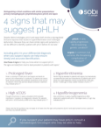Diagnosing HLH
For patients with HLH, prompt diagnosis is crucial
Hemophagocytic lymphohistiocytosis (HLH) is heterogeneous, rapidly progressive, and can be fatal if untreated. It’s critical to ensure that patients are diagnosed as soon as possible.1
It’s also essential to identify any underlying triggers that can be associated with the development of HLH in patients.1
The presence or absence of certain triggers will influence the management strategies you will pursue.2
Diagnosing primary HLH
There are 3 recognized options for making a possible diagnosis of primary HLH. These options include3:
The fulfillment of 5 of the 8 HLH-2004 criteria in the absence of an underlying cause, such as malignancy.
A positive genetic test for mutations associated with primary HLH.
Family history consistent with primary HLH.
It can be challenging to navigate the diagnostic process while also trying to manage a patient’s condition. Explore the sections below for some guidance that you may find helpful.
Things to consider when seeking a diagnosis
View this flash card for information about differential diagnosis between HLH and another condition that can mimic its presentation: sepsis.
References: 1. Jordan MB, Allen CE, Weitzman S, Filipovich AH, McClain KL. How I treat hemophagocytic lymphohistiocytosis. Blood. 2011;118(15):4041-4052. doi:10.1182/blood-2011-03-278127 2. George MR. Hemophagocytic lymphohistiocytosis: review of etiologies and management. J Blood Med. 2014;5:69-86. doi:10.2147/JBM.S46255 3. Henter JI, Horne A, Aricó M, et al. HLH-2004: diagnostic and therapeutic guidelines for hemophagocytic lymphohistiocytosis. Pediatr Blood Cancer. 2007;48(2):124-131. doi:10.1002/pbc.21039
